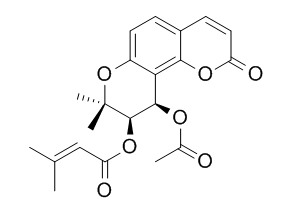Samidin
Samidin has anti-inflammatory properties through suppression of NF-κB and AP-1-mediated-genes in lipopolysaccharide (LPS)-stimulated RAW 264.7 cells.
Inquire / Order:
manager@chemfaces.com
Technical Inquiries:
service@chemfaces.com
Tel:
+86-27-84237783
Fax:
+86-27-84254680
Address:
1 Building, No. 83, CheCheng Rd., Wuhan Economic and Technological Development Zone, Wuhan, Hubei 430056, PRC
Providing storage is as stated on the product vial and the vial is kept tightly sealed, the product can be stored for up to
24 months(2-8C).
Wherever possible, you should prepare and use solutions on the same day. However, if you need to make up stock solutions in advance, we recommend that you store the solution as aliquots in tightly sealed vials at -20C. Generally, these will be useable for up to two weeks. Before use, and prior to opening the vial we recommend that you allow your product to equilibrate to room temperature for at least 1 hour.
Need more advice on solubility, usage and handling? Please email to: service@chemfaces.com
The packaging of the product may have turned upside down during transportation, resulting in the natural compounds adhering to the neck or cap of the vial. take the vial out of its packaging and gently shake to let the compounds fall to the bottom of the vial. for liquid products, centrifuge at 200-500 RPM to gather the liquid at the bottom of the vial. try to avoid loss or contamination during handling.
Food Sci Biotechnol.2016, 25(5):1437-1442
Exp Neurobiol.2018, 27(3):200-209
J.Korean Society of Grassland&Forage Science2023, 43(3):138-147.
Tea Res. Ins. Of China2017, 1-12
Molecules.2019, 24(21):E3834
Evid Based Complement Alternat Med.2021, 8707280.
Cell Physiol Biochem.2017, 43(4):1425-1435
Molecules.2020, 25(9):2081.
LWT2020, 130:109535
Front Plant Sci.2017, 8:723
Related and Featured Products
Arch Pharm Res. 2014 Nov;37(11):1496-503.
Anti-inflammatory properties of samidin from Seseli resinosum through suppression of NF-κB and AP-1-mediated-genes in LPS-stimulated RAW 264.7 cells.[Pubmed:
24988983 ]
Seseli is a herb widely used for its anti-inflammation, anti-flatulence and various other healing properties. In the present study, we investigated the effects of Samidin on the production of pro-inflammatory mediators in lipopolysaccharide (LPS)-stimulated RAW 264.7 cells.
METHODS AND RESULTS:
The results demonstrated that Samidin significantly inhibited the production of nitric oxide, as well as the gene expression levels of inducible nitric oxide synthase and cyclooxygenase-2. The results from an electrophoretic mobility shift assay illustrated that Samidin significantly suppressed NF-κB and AP-1 DNA-binding affinity. In addition, both the NF-κB subunit p65 and the AP-1-related c-jun were markedly inhibited by Samidin. The time course experiment demonstrated that Samidin showed significant inhibitory effect on p38 and JNK activation. Furthermore, tumor necrosis factor-α mRNA level were remarkably down-regulated by Samidin in LPS-stimulated macrophages based on quantitative-real-time polymerase chain reaction.
CONCLUSIONS:
Our results suggested that Samidin has a potential to be developed as a therapeutic agent for various inflammatory diseases.
J Sep Sci. 2016 Oct;39(20):4042-8.
Fast and improved separation of major coumarins in Ammi visnaga (L.) Lam. by supercritical fluid chromatography[Pubmed:
27514847 ]
The first supercritical fluid chromatography method for the determination of five major coumarins (dihydroSamidin, visnadin, Samidin, khellin, and visnagin) in Ammi visnaga fruits is described.
METHODS AND RESULTS:
Their baseline separation was possible in less than 5 min by using a UPC2 HSS C18 SB column with 1.8 μm particle size and a mobile phase comprising CO2 , methanol, acetonitrile, and diethylamine. The type of stationary phase used was of particular relevance because, except for the selected one, the others did not resolve the two structural isomers dihydroSamidin and visnadin. Method validation confirmed that the procedure is linear (R2 ≥ 0.9996) in a concentration range from 6 to 480 μg/mL, it is accurate (recovery rates: 97.2-103.6%) and precise (intraday deviation ≤ 6.6%, intraday deviation ≤ 1.7%); injecting 1 μL of standard solution, the determined limit of detection was below 1.9 μg/mL for all compounds. The analysis of different A. visnaga samples revealed their similar compositions, and khellin (0.75-1.01%) and visnagin (0.18-0.46%) were the dominant coumarins.
CONCLUSIONS:
Visnadin and dihydroSamidin, the individual quantification of which is described for the first time, were present at concentrations below 0.14%.



